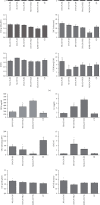Hydration with Mannitol and Dextrose May Promote Cisplatin-Induced Nephrotoxicity: Test of Five Protocols of Hydration during Cisplatin Therapy in Rat Models
- PMID: 34646321
- PMCID: PMC8505073
- DOI: 10.1155/2021/5547341
Hydration with Mannitol and Dextrose May Promote Cisplatin-Induced Nephrotoxicity: Test of Five Protocols of Hydration during Cisplatin Therapy in Rat Models
Abstract
Backgrounds: Cisplatin (CP) still is a novel choice for solid tumor therapy, but it is accompanied with the side effect of nephrotoxicity. Hydration may reduce the risk of CP-induced nephrotoxicity, while the issue is still challenging. In this study, five types of hydration protocols including saline, mannitol, dextrose saline, saline plus furosemide, and saline plus mannitol were examined in both sexes of rats during CP therapy.
Methods: Seventy-six male and female Wistar rats in 14 groups of experiments were subjected to CP therapy, and five types of hydration protocols were implemented, and the induced nephrotoxicity was evaluated via biochemical markers, kidney function parameters, and pathology investigation.
Results: Male and female rats had different responses to hydration protocol types. The higher mortality rate was seen in female rats that received mannitol or dextrose hydration types. In addition, the serum levels of blood urea nitrogen (BUN) and creatinine (Cr) and sodium excretion fraction (ENa%) increased and the clearance of Cr (ClCr) decreased significantly (P < 0.05) in female rats hydrated with saline plus furosemide or mannitol plus saline-treated groups. The worsened condition in male rats is observed in the mannitol hydration group with a significant decrease of ClCr and significant increase of serum BUN and Cr and ENa% (P < 0.05). The higher kidney tissue damage score (KTDS) in the mentioned groups verified the findings.
Conclusion: Hydration with mannitol or dextrose promotes the risk of nephrotoxicity during CP therapy with more intensity on the female.
Copyright © 2021 Mohammad-Sedigh Khosravi et al.
Conflict of interest statement
The authors declare that they have no conflicts of interest.
Figures


Similar articles
-
Saline, mannitol, and furosemide hydration in acute cisplatin nephrotoxicity: a randomized trial.Cancer Chemother Pharmacol. 2003 Jul;52(1):13-8. doi: 10.1007/s00280-003-0620-1. Epub 2003 Apr 29. Cancer Chemother Pharmacol. 2003. PMID: 12719883 Clinical Trial.
-
Hydration with magnesium and mannitol without furosemide prevents the nephrotoxicity induced by cisplatin and pemetrexed in patients with advanced non-small cell lung cancer.J Thorac Dis. 2012 Dec;4(6):562-8. doi: 10.3978/j.issn.2072-1439.2012.10.16. J Thorac Dis. 2012. PMID: 23205279 Free PMC article.
-
Intravenous Administration of Cisplatin with Magnesium Sulfate Supplement May Prevent Kidney Toxicity in Rats: The Role of Gender and Magnesium Sulfate Dose.Int J Nephrol. 2022 Feb 16;2022:1218222. doi: 10.1155/2022/1218222. eCollection 2022. Int J Nephrol. 2022. PMID: 35223098 Free PMC article.
-
The ability of mannitol to decrease cisplatin-induced nephrotoxicity in children: real or not?Cancer Chemother Pharmacol. 2016 Jan;77(1):19-26. doi: 10.1007/s00280-015-2913-6. Epub 2015 Nov 20. Cancer Chemother Pharmacol. 2016. PMID: 26589789 Review.
-
The role of mannitol as a nephroprotectant in patients receiving cisplatin therapy.Ann Pharmacother. 2012 Feb;46(2):276-81. doi: 10.1345/aph.1Q333. Epub 2012 Jan 31. Ann Pharmacother. 2012. PMID: 22298599 Review.
Cited by
-
Sildenafil and furosemide nanoparticles as a novel pharmacological treatment for acute renal failure in rats.Naunyn Schmiedebergs Arch Pharmacol. 2024 Oct;397(10):7865-7879. doi: 10.1007/s00210-024-03128-1. Epub 2024 May 15. Naunyn Schmiedebergs Arch Pharmacol. 2024. PMID: 38748227 Free PMC article.
-
Sex Difference in Cisplatin-Induced Nephrotoxicity: Laboratory and Clinical Findings.J Toxicol. 2022 Oct 10;2022:3507721. doi: 10.1155/2022/3507721. eCollection 2022. J Toxicol. 2022. PMID: 36263084 Free PMC article. Review.
-
Calcium dobesilate ameliorates hepatorenal injury induced by carbon tetrachloride in mice.Iran J Basic Med Sci. 2022 Feb;25(2):148-154. doi: 10.22038/IJBMS.2022.61499.13606. Iran J Basic Med Sci. 2022. PMID: 35655592 Free PMC article.
References
LinkOut - more resources
Full Text Sources
Miscellaneous

